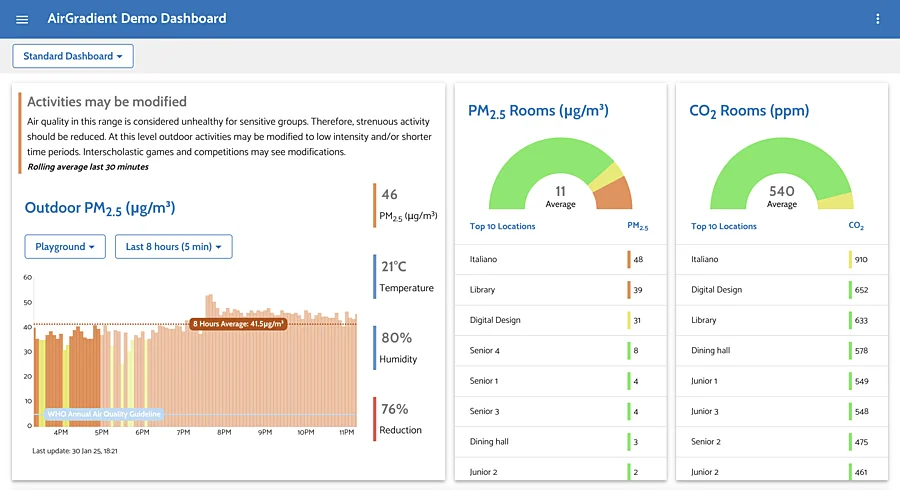The Open Air Max measures PM, CO2, TVOCs, NO2, O3, Temperature and Humidity.
The PM sensor (Plantower PMS5003) measures particulate matter, especially smaller particles like PM2.5, which have the potential to cause significant harm to our well-being. These tiny particles are released into the air through various sources such as vehicle emissions, industrial activities, burning of fossil fuels or wildfires. When inhaled, these small particles can penetrate deep into our respiratory system, leading to a range of health issues. Long-term exposure to PM2.5 has been linked to respiratory and cardiovascular diseases, including asthma, bronchitis, heart attacks, and even premature death.
The Open Air Max includes two PMS5003 modules, allowing for redundancy and self-calibration. This self-calibration process allows the Open Air Max to continue providing accurate readings without long-term drift.
We have also included a Sensirion SHT40 temperature and humidity sensor. This sensor is isolated from other components to allow for more accurate measurements that better reflect the ambient conditions.
The CO2 sensor (SenseAir S8) provides valuable insights into local emission sources. Elevated CO2 levels detected by this sensor can serve as indirect indicators of other harmful gases frequently emitted alongside CO2, such as sulfur dioxide (SO2), and carbon monodioxide (CO). These gases may not always be apparent through particulate matter (PM) measurements, especially in scenarios where power plants or industrial facilities use advanced filtration systems. Another critical application of the sensor is monitoring for potential leaks from underground carbon storage facilities. While the sensor is not designed to measure subtle atmospheric CO2 trends (e.g., the global increase of around 430 ppm), our internal testing demonstrates a strong correlation with reference-grade instruments.
Additionally, the Open Air Max is equipped with both NO2 and O3 sensors from AlphaSense. While many NO2 sensors exhibit cross-sensitivity to ozone (O3), the inclusion of separate, dedicated sensors ensures precise measurements for both pollutants. This dual-sensor approach enhances the monitor’s ability to meet regulatory requirements and align with air quality standards and guidelines, such as those outlined in the Clean Air Act.
The monitor also integrates the Sensirion SGP41 sensor for total volatile organic compounds (TVOCs) and NOX. This sensor detects relative spikes in VOCs and nitrogen oxides using the Sensirion VOC Index. Although VOCs are commonly associated with indoor environments, they are also prevalent outdoors, originating from sources such as chemical plants, fuel stations, natural gas leaks, and waste burning. It is worth noting that VOC readings may be influenced by non-harmful substances like ethanol or sunscreen, meaning elevated values do not always indicate hazardous conditions.




